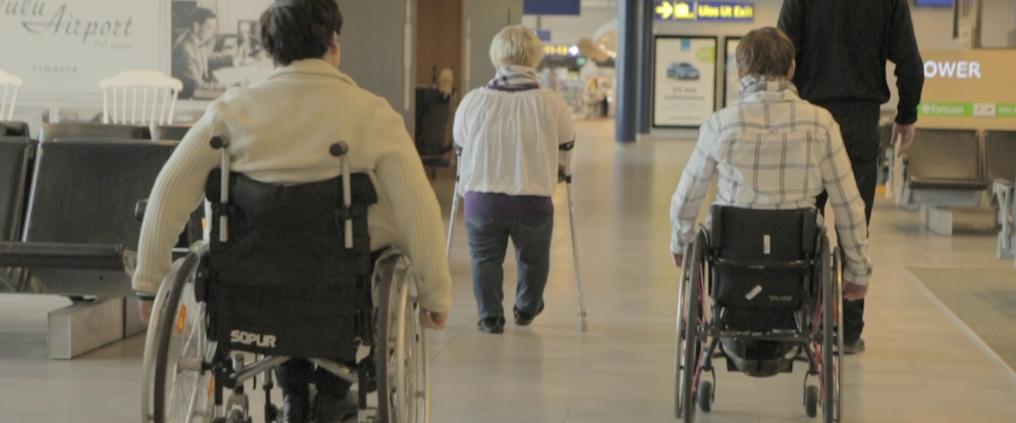Yearly, Finnish airports serve thousands of passengers with reduced mobility. Many of them request assistance during their travel.
In Oulu, airport staff were trained on how to assist passengers with reduced mobility and how to help wheelchair passengers board an aircraft. The training was led by true experts: four locals who fly frequently and have some physical characteristics that somehow reduce their mobility.
“The goal of the training was to encourage our staff to serve our customers better,” says Airpro Oulu manager Vesa Martikainen. “It’s important for us that passengers with reduced mobility can travel through the airport comfortably and that great customer service is made available to all passengers.”
Flying is for everyone
In the EU, disabled persons and persons with reduced mobility have the right to travel like any other passenger and have equal opportunities to do so. They must be offered free assistance at the airport and during their air travel and have the right to transport two pieces of mobility equipment, such as a wheelchair, free of charge.
“The best part about flying is that despite having a physical disability or using a wheelchair to get around, you are able to fly and see the world,” says Tiina Logrén, who herself uses a wheelchair. “The assistance services at airports usually work really well.”
Logrén was one of the four people heading the training in Oulu.
As the degree of reduced mobility differs from one person to the next, the need for assistance also varies greatly. Some people need a wheelchair for all transport. Others may be able to walk, but need help with long distances, stairs or handling their luggage. Passengers should request assistance at least 48 hours before their flight.
“The need for assistance depends on the nature of the person’s disability, as well as the type of travel, and whether they are travelling with a personal assistant,” says Piia Jolla, who works as a specialist for the Finnish CP Association. “The most important thing is to take different needs into consideration.”
Learning the right technique
As a personal wheelchair is always transported in cargo, a wheelchair passenger will often need personal assistance to board aircraft. They are first moved onto a special assistance chair, which fits inside the aircraft, and then assisted to their own seat, usually a window seat for safety reasons.
“Employees can be a bit nervous in these situations and unsure of how to assist a person in a wheelchair. It’s important for them to know that even though someone is in a wheelchair, it is okay to touch them and to ask them whether they mind physical contact and how to assist them,” Logren says.
Usually, two staff members are needed to assist the wheelchair passenger during boarding. One will reach under the passenger’s arms and take a firm hold of their wrists, while the other will lift the passenger by the legs.
In Oulu, staff members got to train using the right technique along with Logrén and Jolla’s assistance and advice.
“Boarding usually goes well, as the employees know the right technique,” Logrén says.
Exchanging useful information
The training in Oulu also included a lot of information about the needs and wishes of passengers with reduced mobility and what kind of help they would like to receive at the airport.
“Often the problems disabled people run into will never even be noticed by someone who isn’t in the same situation. That’s why you can never talk about this stuff too much,” Jolla says.
And even though it’s important to be aware of the right techniques and equipment for assisting passengers with reduced mobility, Jolla and Logrén say that the most important thing is to treat people with respect.
“You can talk to a person completely normally, even though he or she is in a wheelchair or have some physical disability. For me, the wheelchair is like my legs. I don’t stop to think about being in a wheelchair anymore when I travel. I’m just like any other person,” says Logrén.
Read more about airport services for passengers requiring assistance.



